BAO2203 Assignment: Conceptual Framework Financial Reporting Analysis
VerifiedAdded on 2023/06/07
|12
|2935
|424
Report
AI Summary
This report undertakes a comprehensive analysis of the conceptual framework for financial reporting, as outlined by the IASB and IFRS. The report begins by examining financial statements of three companies, comparing their revenue, expenses, and profit/loss, and assessing their compliance with Australian and International Accounting Standards. It then delves into the issue of 'boilerplate' disclosure, evaluating how management practices can lead to the presentation of generic and irrelevant financial information. The report further investigates the sufficiency of the definitions of operating profit and EBIT within the IFRS framework, highlighting potential ambiguities and challenges faced by businesses. Finally, it assesses the IASB's definition of profit or loss and other comprehensive income, considering its usefulness in meeting the needs of stakeholders and ensuring faithful representation of financial performance. The report concludes by summarizing the findings and implications of the analysis.
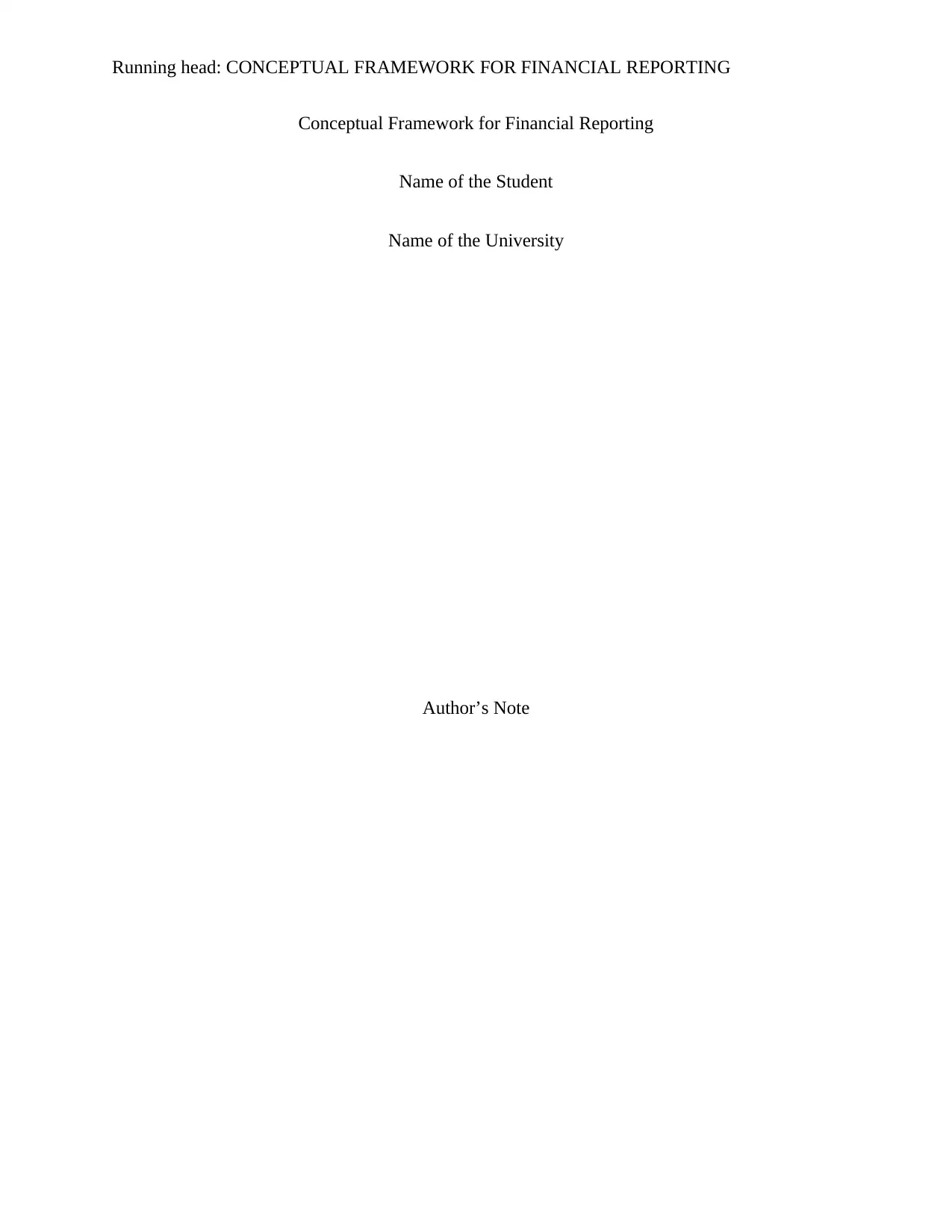
Running head: CONCEPTUAL FRAMEWORK FOR FINANCIAL REPORTING
Conceptual Framework for Financial Reporting
Name of the Student
Name of the University
Author’s Note
Conceptual Framework for Financial Reporting
Name of the Student
Name of the University
Author’s Note
Paraphrase This Document
Need a fresh take? Get an instant paraphrase of this document with our AI Paraphraser
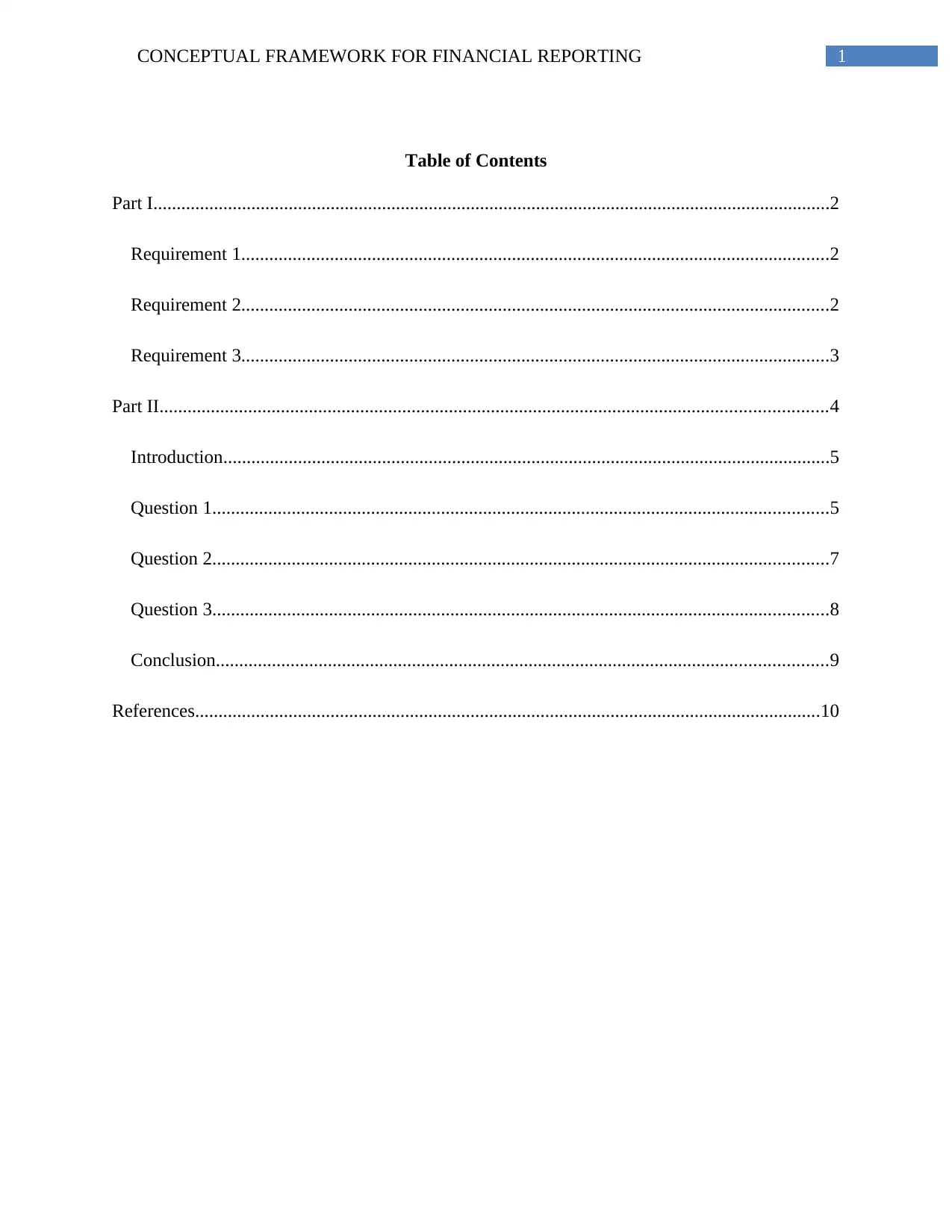
1CONCEPTUAL FRAMEWORK FOR FINANCIAL REPORTING
Table of Contents
Part I.................................................................................................................................................2
Requirement 1..............................................................................................................................2
Requirement 2..............................................................................................................................2
Requirement 3..............................................................................................................................3
Part II...............................................................................................................................................4
Introduction..................................................................................................................................5
Question 1....................................................................................................................................5
Question 2....................................................................................................................................7
Question 3....................................................................................................................................8
Conclusion...................................................................................................................................9
References......................................................................................................................................10
Table of Contents
Part I.................................................................................................................................................2
Requirement 1..............................................................................................................................2
Requirement 2..............................................................................................................................2
Requirement 3..............................................................................................................................3
Part II...............................................................................................................................................4
Introduction..................................................................................................................................5
Question 1....................................................................................................................................5
Question 2....................................................................................................................................7
Question 3....................................................................................................................................8
Conclusion...................................................................................................................................9
References......................................................................................................................................10
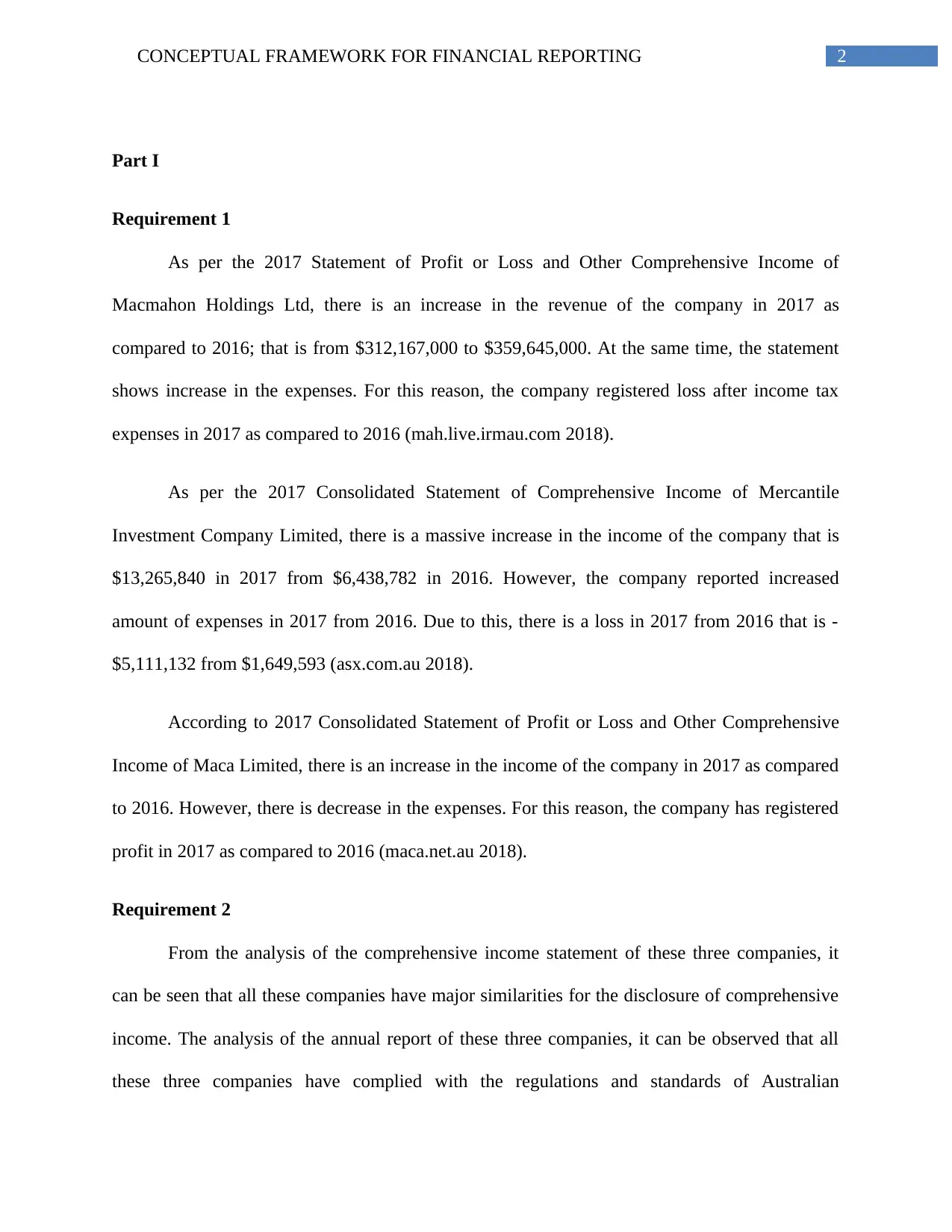
2CONCEPTUAL FRAMEWORK FOR FINANCIAL REPORTING
Part I
Requirement 1
As per the 2017 Statement of Profit or Loss and Other Comprehensive Income of
Macmahon Holdings Ltd, there is an increase in the revenue of the company in 2017 as
compared to 2016; that is from $312,167,000 to $359,645,000. At the same time, the statement
shows increase in the expenses. For this reason, the company registered loss after income tax
expenses in 2017 as compared to 2016 (mah.live.irmau.com 2018).
As per the 2017 Consolidated Statement of Comprehensive Income of Mercantile
Investment Company Limited, there is a massive increase in the income of the company that is
$13,265,840 in 2017 from $6,438,782 in 2016. However, the company reported increased
amount of expenses in 2017 from 2016. Due to this, there is a loss in 2017 from 2016 that is -
$5,111,132 from $1,649,593 (asx.com.au 2018).
According to 2017 Consolidated Statement of Profit or Loss and Other Comprehensive
Income of Maca Limited, there is an increase in the income of the company in 2017 as compared
to 2016. However, there is decrease in the expenses. For this reason, the company has registered
profit in 2017 as compared to 2016 (maca.net.au 2018).
Requirement 2
From the analysis of the comprehensive income statement of these three companies, it
can be seen that all these companies have major similarities for the disclosure of comprehensive
income. The analysis of the annual report of these three companies, it can be observed that all
these three companies have complied with the regulations and standards of Australian
Part I
Requirement 1
As per the 2017 Statement of Profit or Loss and Other Comprehensive Income of
Macmahon Holdings Ltd, there is an increase in the revenue of the company in 2017 as
compared to 2016; that is from $312,167,000 to $359,645,000. At the same time, the statement
shows increase in the expenses. For this reason, the company registered loss after income tax
expenses in 2017 as compared to 2016 (mah.live.irmau.com 2018).
As per the 2017 Consolidated Statement of Comprehensive Income of Mercantile
Investment Company Limited, there is a massive increase in the income of the company that is
$13,265,840 in 2017 from $6,438,782 in 2016. However, the company reported increased
amount of expenses in 2017 from 2016. Due to this, there is a loss in 2017 from 2016 that is -
$5,111,132 from $1,649,593 (asx.com.au 2018).
According to 2017 Consolidated Statement of Profit or Loss and Other Comprehensive
Income of Maca Limited, there is an increase in the income of the company in 2017 as compared
to 2016. However, there is decrease in the expenses. For this reason, the company has registered
profit in 2017 as compared to 2016 (maca.net.au 2018).
Requirement 2
From the analysis of the comprehensive income statement of these three companies, it
can be seen that all these companies have major similarities for the disclosure of comprehensive
income. The analysis of the annual report of these three companies, it can be observed that all
these three companies have complied with the regulations and standards of Australian
⊘ This is a preview!⊘
Do you want full access?
Subscribe today to unlock all pages.

Trusted by 1+ million students worldwide
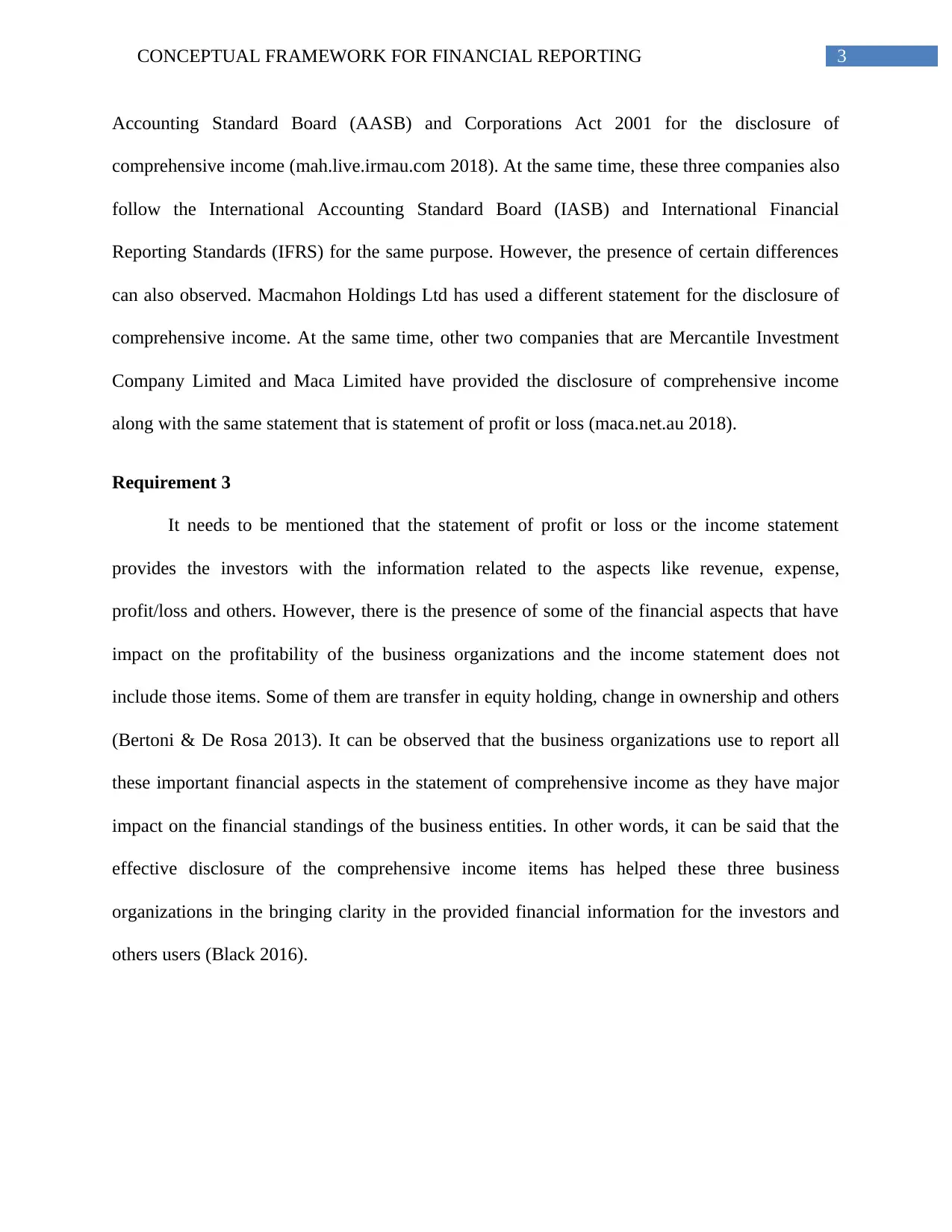
3CONCEPTUAL FRAMEWORK FOR FINANCIAL REPORTING
Accounting Standard Board (AASB) and Corporations Act 2001 for the disclosure of
comprehensive income (mah.live.irmau.com 2018). At the same time, these three companies also
follow the International Accounting Standard Board (IASB) and International Financial
Reporting Standards (IFRS) for the same purpose. However, the presence of certain differences
can also observed. Macmahon Holdings Ltd has used a different statement for the disclosure of
comprehensive income. At the same time, other two companies that are Mercantile Investment
Company Limited and Maca Limited have provided the disclosure of comprehensive income
along with the same statement that is statement of profit or loss (maca.net.au 2018).
Requirement 3
It needs to be mentioned that the statement of profit or loss or the income statement
provides the investors with the information related to the aspects like revenue, expense,
profit/loss and others. However, there is the presence of some of the financial aspects that have
impact on the profitability of the business organizations and the income statement does not
include those items. Some of them are transfer in equity holding, change in ownership and others
(Bertoni & De Rosa 2013). It can be observed that the business organizations use to report all
these important financial aspects in the statement of comprehensive income as they have major
impact on the financial standings of the business entities. In other words, it can be said that the
effective disclosure of the comprehensive income items has helped these three business
organizations in the bringing clarity in the provided financial information for the investors and
others users (Black 2016).
Accounting Standard Board (AASB) and Corporations Act 2001 for the disclosure of
comprehensive income (mah.live.irmau.com 2018). At the same time, these three companies also
follow the International Accounting Standard Board (IASB) and International Financial
Reporting Standards (IFRS) for the same purpose. However, the presence of certain differences
can also observed. Macmahon Holdings Ltd has used a different statement for the disclosure of
comprehensive income. At the same time, other two companies that are Mercantile Investment
Company Limited and Maca Limited have provided the disclosure of comprehensive income
along with the same statement that is statement of profit or loss (maca.net.au 2018).
Requirement 3
It needs to be mentioned that the statement of profit or loss or the income statement
provides the investors with the information related to the aspects like revenue, expense,
profit/loss and others. However, there is the presence of some of the financial aspects that have
impact on the profitability of the business organizations and the income statement does not
include those items. Some of them are transfer in equity holding, change in ownership and others
(Bertoni & De Rosa 2013). It can be observed that the business organizations use to report all
these important financial aspects in the statement of comprehensive income as they have major
impact on the financial standings of the business entities. In other words, it can be said that the
effective disclosure of the comprehensive income items has helped these three business
organizations in the bringing clarity in the provided financial information for the investors and
others users (Black 2016).
Paraphrase This Document
Need a fresh take? Get an instant paraphrase of this document with our AI Paraphraser

4CONCEPTUAL FRAMEWORK FOR FINANCIAL REPORTING
Part II
Abstract
The main aim of this report is the analysis of three major aspects. As per the first part of the
report, the managements of the companies do use ‘boilerplate’ disclosure for the financial
statements. As per the second part, provided definition of operating profit and EBIT is not
enough for the users. As per the third part, the IASB definition of profit or loss and other
comprehensive income is useful for the users.
Part II
Abstract
The main aim of this report is the analysis of three major aspects. As per the first part of the
report, the managements of the companies do use ‘boilerplate’ disclosure for the financial
statements. As per the second part, provided definition of operating profit and EBIT is not
enough for the users. As per the third part, the IASB definition of profit or loss and other
comprehensive income is useful for the users.
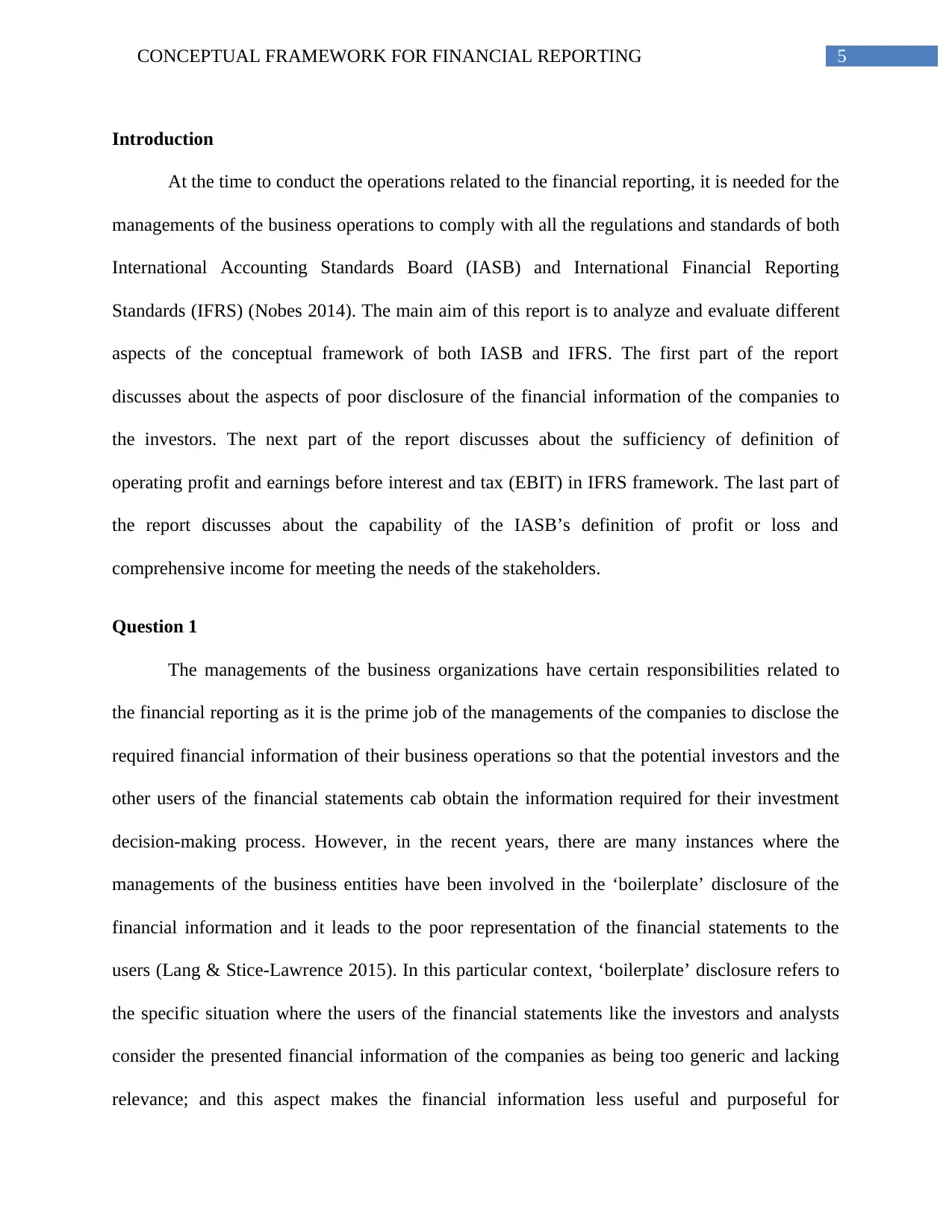
5CONCEPTUAL FRAMEWORK FOR FINANCIAL REPORTING
Introduction
At the time to conduct the operations related to the financial reporting, it is needed for the
managements of the business operations to comply with all the regulations and standards of both
International Accounting Standards Board (IASB) and International Financial Reporting
Standards (IFRS) (Nobes 2014). The main aim of this report is to analyze and evaluate different
aspects of the conceptual framework of both IASB and IFRS. The first part of the report
discusses about the aspects of poor disclosure of the financial information of the companies to
the investors. The next part of the report discusses about the sufficiency of definition of
operating profit and earnings before interest and tax (EBIT) in IFRS framework. The last part of
the report discusses about the capability of the IASB’s definition of profit or loss and
comprehensive income for meeting the needs of the stakeholders.
Question 1
The managements of the business organizations have certain responsibilities related to
the financial reporting as it is the prime job of the managements of the companies to disclose the
required financial information of their business operations so that the potential investors and the
other users of the financial statements cab obtain the information required for their investment
decision-making process. However, in the recent years, there are many instances where the
managements of the business entities have been involved in the ‘boilerplate’ disclosure of the
financial information and it leads to the poor representation of the financial statements to the
users (Lang & Stice-Lawrence 2015). In this particular context, ‘boilerplate’ disclosure refers to
the specific situation where the users of the financial statements like the investors and analysts
consider the presented financial information of the companies as being too generic and lacking
relevance; and this aspect makes the financial information less useful and purposeful for
Introduction
At the time to conduct the operations related to the financial reporting, it is needed for the
managements of the business operations to comply with all the regulations and standards of both
International Accounting Standards Board (IASB) and International Financial Reporting
Standards (IFRS) (Nobes 2014). The main aim of this report is to analyze and evaluate different
aspects of the conceptual framework of both IASB and IFRS. The first part of the report
discusses about the aspects of poor disclosure of the financial information of the companies to
the investors. The next part of the report discusses about the sufficiency of definition of
operating profit and earnings before interest and tax (EBIT) in IFRS framework. The last part of
the report discusses about the capability of the IASB’s definition of profit or loss and
comprehensive income for meeting the needs of the stakeholders.
Question 1
The managements of the business organizations have certain responsibilities related to
the financial reporting as it is the prime job of the managements of the companies to disclose the
required financial information of their business operations so that the potential investors and the
other users of the financial statements cab obtain the information required for their investment
decision-making process. However, in the recent years, there are many instances where the
managements of the business entities have been involved in the ‘boilerplate’ disclosure of the
financial information and it leads to the poor representation of the financial statements to the
users (Lang & Stice-Lawrence 2015). In this particular context, ‘boilerplate’ disclosure refers to
the specific situation where the users of the financial statements like the investors and analysts
consider the presented financial information of the companies as being too generic and lacking
relevance; and this aspect makes the financial information less useful and purposeful for
⊘ This is a preview!⊘
Do you want full access?
Subscribe today to unlock all pages.

Trusted by 1+ million students worldwide
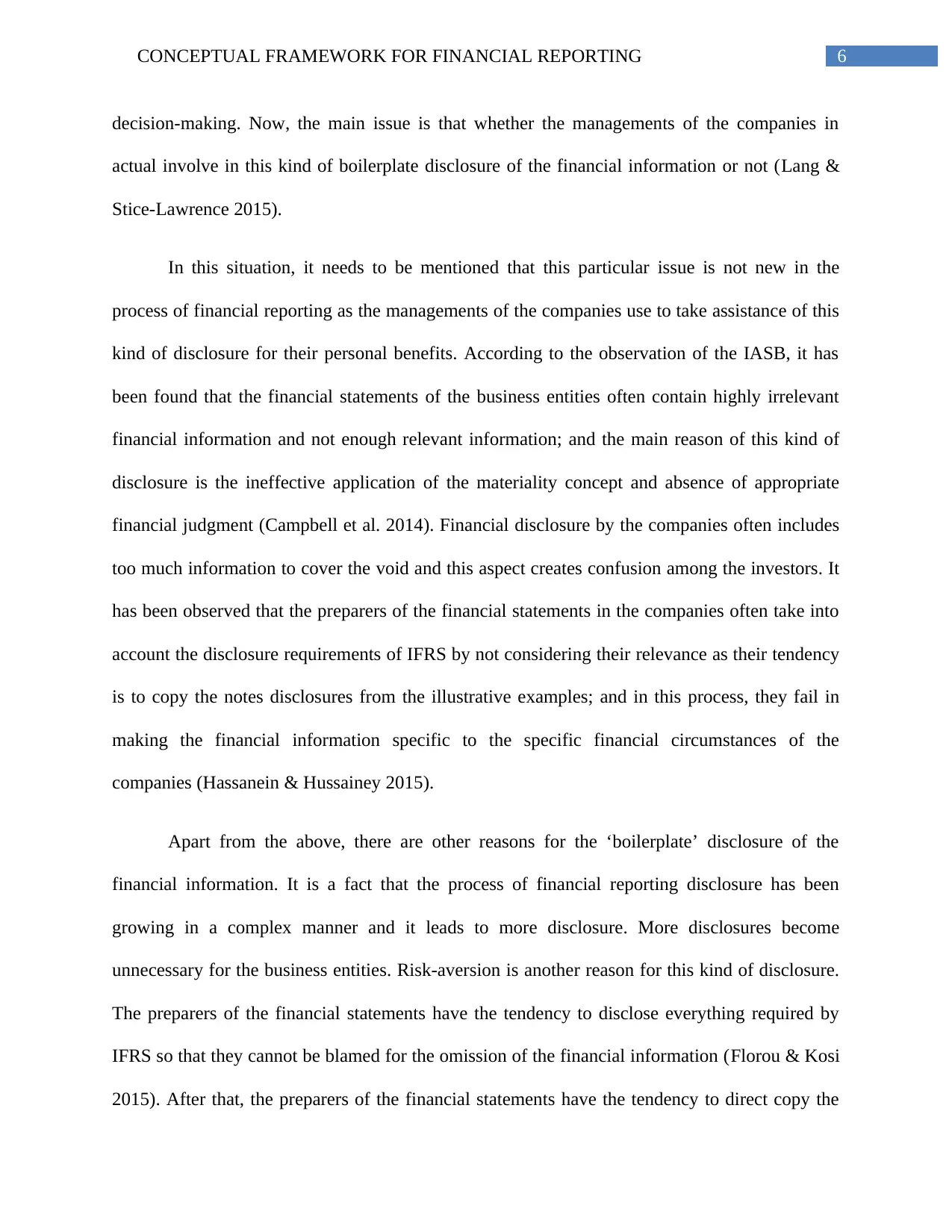
6CONCEPTUAL FRAMEWORK FOR FINANCIAL REPORTING
decision-making. Now, the main issue is that whether the managements of the companies in
actual involve in this kind of boilerplate disclosure of the financial information or not (Lang &
Stice-Lawrence 2015).
In this situation, it needs to be mentioned that this particular issue is not new in the
process of financial reporting as the managements of the companies use to take assistance of this
kind of disclosure for their personal benefits. According to the observation of the IASB, it has
been found that the financial statements of the business entities often contain highly irrelevant
financial information and not enough relevant information; and the main reason of this kind of
disclosure is the ineffective application of the materiality concept and absence of appropriate
financial judgment (Campbell et al. 2014). Financial disclosure by the companies often includes
too much information to cover the void and this aspect creates confusion among the investors. It
has been observed that the preparers of the financial statements in the companies often take into
account the disclosure requirements of IFRS by not considering their relevance as their tendency
is to copy the notes disclosures from the illustrative examples; and in this process, they fail in
making the financial information specific to the specific financial circumstances of the
companies (Hassanein & Hussainey 2015).
Apart from the above, there are other reasons for the ‘boilerplate’ disclosure of the
financial information. It is a fact that the process of financial reporting disclosure has been
growing in a complex manner and it leads to more disclosure. More disclosures become
unnecessary for the business entities. Risk-aversion is another reason for this kind of disclosure.
The preparers of the financial statements have the tendency to disclose everything required by
IFRS so that they cannot be blamed for the omission of the financial information (Florou & Kosi
2015). After that, the preparers of the financial statements have the tendency to direct copy the
decision-making. Now, the main issue is that whether the managements of the companies in
actual involve in this kind of boilerplate disclosure of the financial information or not (Lang &
Stice-Lawrence 2015).
In this situation, it needs to be mentioned that this particular issue is not new in the
process of financial reporting as the managements of the companies use to take assistance of this
kind of disclosure for their personal benefits. According to the observation of the IASB, it has
been found that the financial statements of the business entities often contain highly irrelevant
financial information and not enough relevant information; and the main reason of this kind of
disclosure is the ineffective application of the materiality concept and absence of appropriate
financial judgment (Campbell et al. 2014). Financial disclosure by the companies often includes
too much information to cover the void and this aspect creates confusion among the investors. It
has been observed that the preparers of the financial statements in the companies often take into
account the disclosure requirements of IFRS by not considering their relevance as their tendency
is to copy the notes disclosures from the illustrative examples; and in this process, they fail in
making the financial information specific to the specific financial circumstances of the
companies (Hassanein & Hussainey 2015).
Apart from the above, there are other reasons for the ‘boilerplate’ disclosure of the
financial information. It is a fact that the process of financial reporting disclosure has been
growing in a complex manner and it leads to more disclosure. More disclosures become
unnecessary for the business entities. Risk-aversion is another reason for this kind of disclosure.
The preparers of the financial statements have the tendency to disclose everything required by
IFRS so that they cannot be blamed for the omission of the financial information (Florou & Kosi
2015). After that, the preparers of the financial statements have the tendency to direct copy the
Paraphrase This Document
Need a fresh take? Get an instant paraphrase of this document with our AI Paraphraser
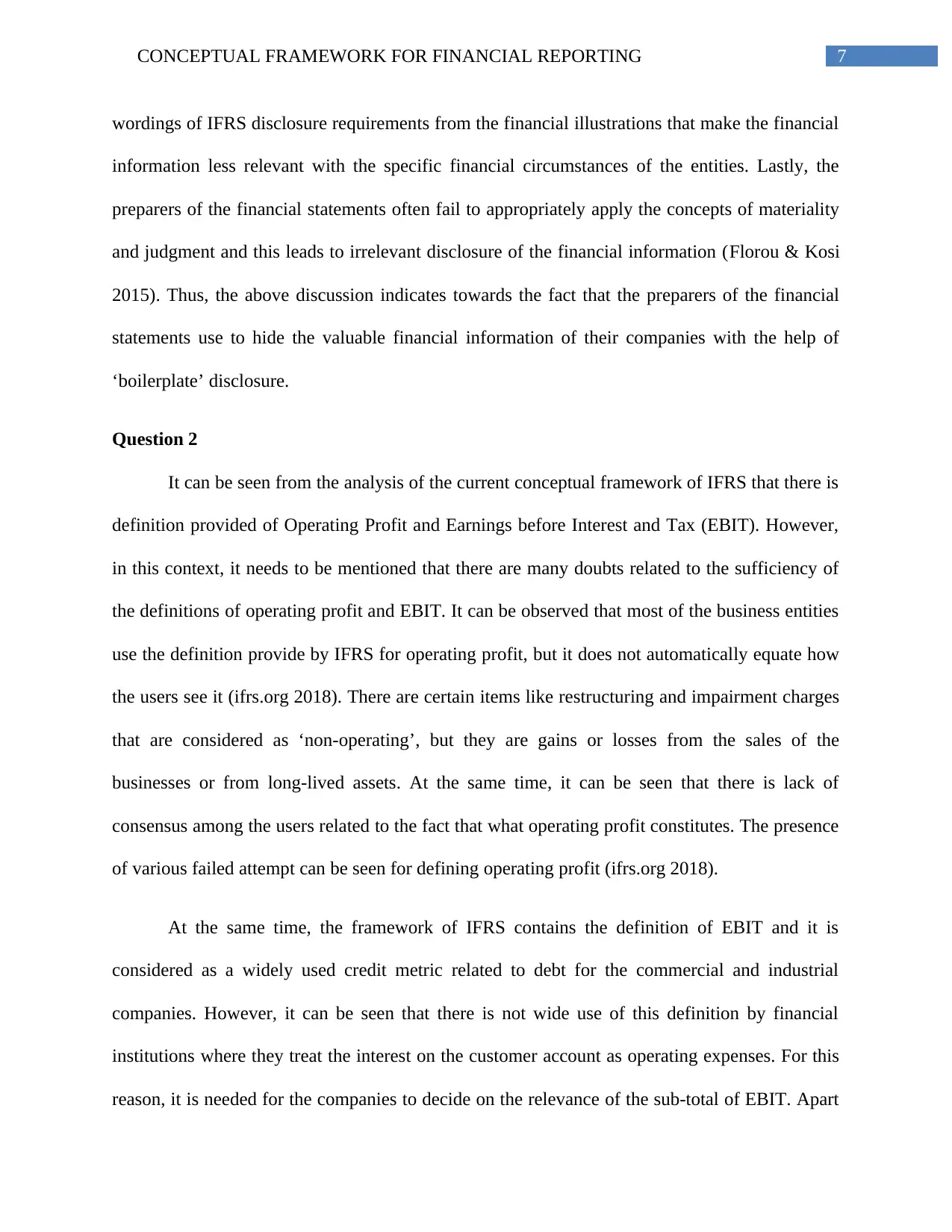
7CONCEPTUAL FRAMEWORK FOR FINANCIAL REPORTING
wordings of IFRS disclosure requirements from the financial illustrations that make the financial
information less relevant with the specific financial circumstances of the entities. Lastly, the
preparers of the financial statements often fail to appropriately apply the concepts of materiality
and judgment and this leads to irrelevant disclosure of the financial information (Florou & Kosi
2015). Thus, the above discussion indicates towards the fact that the preparers of the financial
statements use to hide the valuable financial information of their companies with the help of
‘boilerplate’ disclosure.
Question 2
It can be seen from the analysis of the current conceptual framework of IFRS that there is
definition provided of Operating Profit and Earnings before Interest and Tax (EBIT). However,
in this context, it needs to be mentioned that there are many doubts related to the sufficiency of
the definitions of operating profit and EBIT. It can be observed that most of the business entities
use the definition provide by IFRS for operating profit, but it does not automatically equate how
the users see it (ifrs.org 2018). There are certain items like restructuring and impairment charges
that are considered as ‘non-operating’, but they are gains or losses from the sales of the
businesses or from long-lived assets. At the same time, it can be seen that there is lack of
consensus among the users related to the fact that what operating profit constitutes. The presence
of various failed attempt can be seen for defining operating profit (ifrs.org 2018).
At the same time, the framework of IFRS contains the definition of EBIT and it is
considered as a widely used credit metric related to debt for the commercial and industrial
companies. However, it can be seen that there is not wide use of this definition by financial
institutions where they treat the interest on the customer account as operating expenses. For this
reason, it is needed for the companies to decide on the relevance of the sub-total of EBIT. Apart
wordings of IFRS disclosure requirements from the financial illustrations that make the financial
information less relevant with the specific financial circumstances of the entities. Lastly, the
preparers of the financial statements often fail to appropriately apply the concepts of materiality
and judgment and this leads to irrelevant disclosure of the financial information (Florou & Kosi
2015). Thus, the above discussion indicates towards the fact that the preparers of the financial
statements use to hide the valuable financial information of their companies with the help of
‘boilerplate’ disclosure.
Question 2
It can be seen from the analysis of the current conceptual framework of IFRS that there is
definition provided of Operating Profit and Earnings before Interest and Tax (EBIT). However,
in this context, it needs to be mentioned that there are many doubts related to the sufficiency of
the definitions of operating profit and EBIT. It can be observed that most of the business entities
use the definition provide by IFRS for operating profit, but it does not automatically equate how
the users see it (ifrs.org 2018). There are certain items like restructuring and impairment charges
that are considered as ‘non-operating’, but they are gains or losses from the sales of the
businesses or from long-lived assets. At the same time, it can be seen that there is lack of
consensus among the users related to the fact that what operating profit constitutes. The presence
of various failed attempt can be seen for defining operating profit (ifrs.org 2018).
At the same time, the framework of IFRS contains the definition of EBIT and it is
considered as a widely used credit metric related to debt for the commercial and industrial
companies. However, it can be seen that there is not wide use of this definition by financial
institutions where they treat the interest on the customer account as operating expenses. For this
reason, it is needed for the companies to decide on the relevance of the sub-total of EBIT. Apart
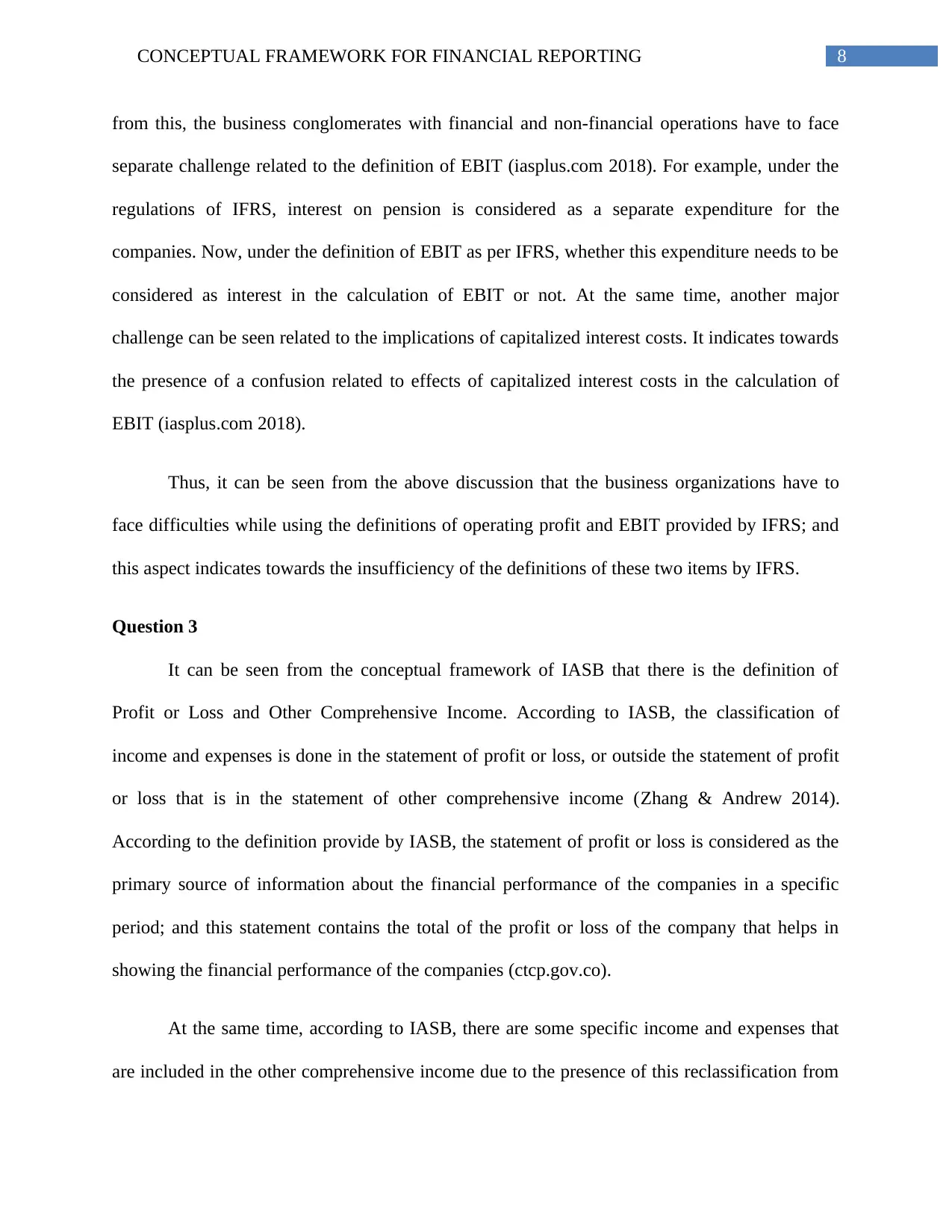
8CONCEPTUAL FRAMEWORK FOR FINANCIAL REPORTING
from this, the business conglomerates with financial and non-financial operations have to face
separate challenge related to the definition of EBIT (iasplus.com 2018). For example, under the
regulations of IFRS, interest on pension is considered as a separate expenditure for the
companies. Now, under the definition of EBIT as per IFRS, whether this expenditure needs to be
considered as interest in the calculation of EBIT or not. At the same time, another major
challenge can be seen related to the implications of capitalized interest costs. It indicates towards
the presence of a confusion related to effects of capitalized interest costs in the calculation of
EBIT (iasplus.com 2018).
Thus, it can be seen from the above discussion that the business organizations have to
face difficulties while using the definitions of operating profit and EBIT provided by IFRS; and
this aspect indicates towards the insufficiency of the definitions of these two items by IFRS.
Question 3
It can be seen from the conceptual framework of IASB that there is the definition of
Profit or Loss and Other Comprehensive Income. According to IASB, the classification of
income and expenses is done in the statement of profit or loss, or outside the statement of profit
or loss that is in the statement of other comprehensive income (Zhang & Andrew 2014).
According to the definition provide by IASB, the statement of profit or loss is considered as the
primary source of information about the financial performance of the companies in a specific
period; and this statement contains the total of the profit or loss of the company that helps in
showing the financial performance of the companies (ctcp.gov.co).
At the same time, according to IASB, there are some specific income and expenses that
are included in the other comprehensive income due to the presence of this reclassification from
from this, the business conglomerates with financial and non-financial operations have to face
separate challenge related to the definition of EBIT (iasplus.com 2018). For example, under the
regulations of IFRS, interest on pension is considered as a separate expenditure for the
companies. Now, under the definition of EBIT as per IFRS, whether this expenditure needs to be
considered as interest in the calculation of EBIT or not. At the same time, another major
challenge can be seen related to the implications of capitalized interest costs. It indicates towards
the presence of a confusion related to effects of capitalized interest costs in the calculation of
EBIT (iasplus.com 2018).
Thus, it can be seen from the above discussion that the business organizations have to
face difficulties while using the definitions of operating profit and EBIT provided by IFRS; and
this aspect indicates towards the insufficiency of the definitions of these two items by IFRS.
Question 3
It can be seen from the conceptual framework of IASB that there is the definition of
Profit or Loss and Other Comprehensive Income. According to IASB, the classification of
income and expenses is done in the statement of profit or loss, or outside the statement of profit
or loss that is in the statement of other comprehensive income (Zhang & Andrew 2014).
According to the definition provide by IASB, the statement of profit or loss is considered as the
primary source of information about the financial performance of the companies in a specific
period; and this statement contains the total of the profit or loss of the company that helps in
showing the financial performance of the companies (ctcp.gov.co).
At the same time, according to IASB, there are some specific income and expenses that
are included in the other comprehensive income due to the presence of this reclassification from
⊘ This is a preview!⊘
Do you want full access?
Subscribe today to unlock all pages.

Trusted by 1+ million students worldwide
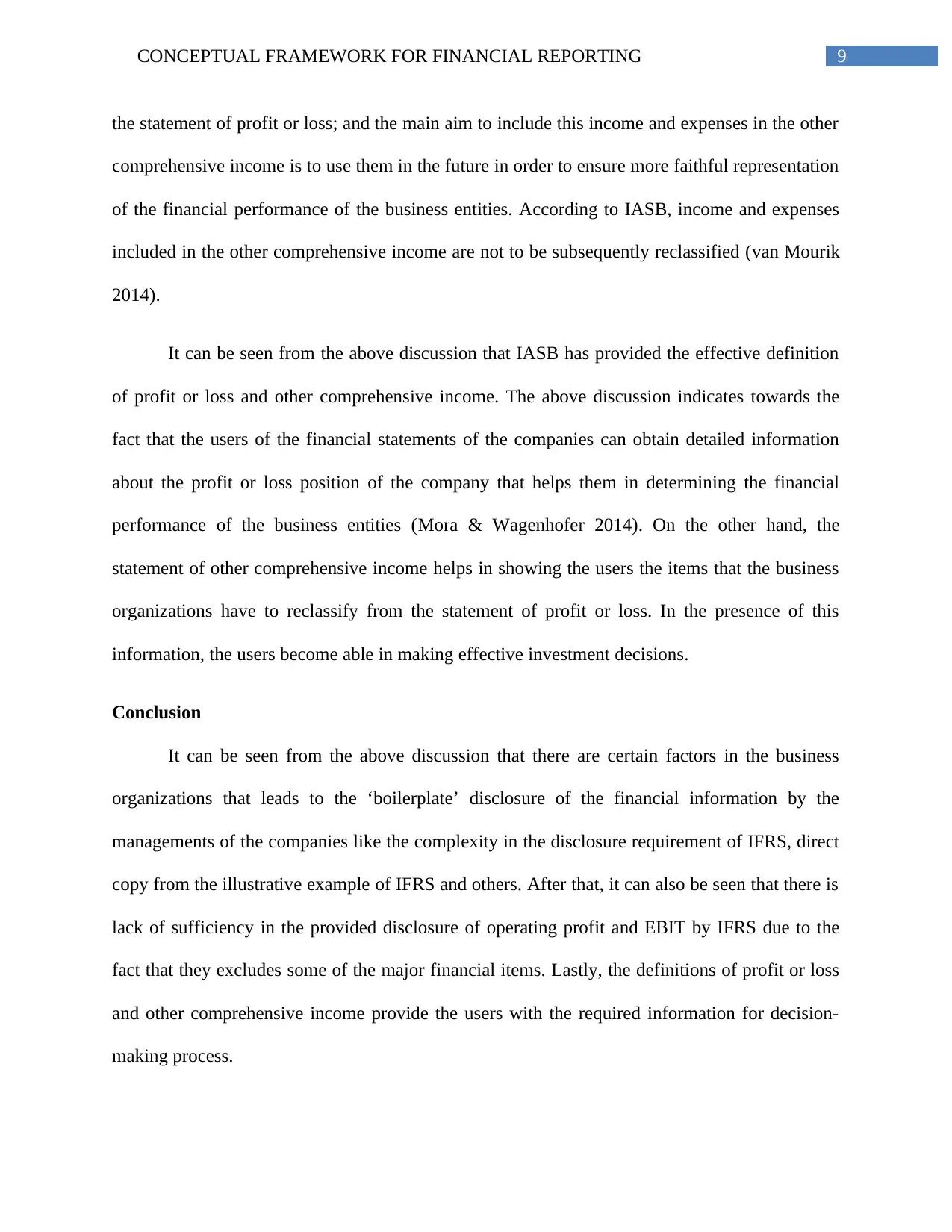
9CONCEPTUAL FRAMEWORK FOR FINANCIAL REPORTING
the statement of profit or loss; and the main aim to include this income and expenses in the other
comprehensive income is to use them in the future in order to ensure more faithful representation
of the financial performance of the business entities. According to IASB, income and expenses
included in the other comprehensive income are not to be subsequently reclassified (van Mourik
2014).
It can be seen from the above discussion that IASB has provided the effective definition
of profit or loss and other comprehensive income. The above discussion indicates towards the
fact that the users of the financial statements of the companies can obtain detailed information
about the profit or loss position of the company that helps them in determining the financial
performance of the business entities (Mora & Wagenhofer 2014). On the other hand, the
statement of other comprehensive income helps in showing the users the items that the business
organizations have to reclassify from the statement of profit or loss. In the presence of this
information, the users become able in making effective investment decisions.
Conclusion
It can be seen from the above discussion that there are certain factors in the business
organizations that leads to the ‘boilerplate’ disclosure of the financial information by the
managements of the companies like the complexity in the disclosure requirement of IFRS, direct
copy from the illustrative example of IFRS and others. After that, it can also be seen that there is
lack of sufficiency in the provided disclosure of operating profit and EBIT by IFRS due to the
fact that they excludes some of the major financial items. Lastly, the definitions of profit or loss
and other comprehensive income provide the users with the required information for decision-
making process.
the statement of profit or loss; and the main aim to include this income and expenses in the other
comprehensive income is to use them in the future in order to ensure more faithful representation
of the financial performance of the business entities. According to IASB, income and expenses
included in the other comprehensive income are not to be subsequently reclassified (van Mourik
2014).
It can be seen from the above discussion that IASB has provided the effective definition
of profit or loss and other comprehensive income. The above discussion indicates towards the
fact that the users of the financial statements of the companies can obtain detailed information
about the profit or loss position of the company that helps them in determining the financial
performance of the business entities (Mora & Wagenhofer 2014). On the other hand, the
statement of other comprehensive income helps in showing the users the items that the business
organizations have to reclassify from the statement of profit or loss. In the presence of this
information, the users become able in making effective investment decisions.
Conclusion
It can be seen from the above discussion that there are certain factors in the business
organizations that leads to the ‘boilerplate’ disclosure of the financial information by the
managements of the companies like the complexity in the disclosure requirement of IFRS, direct
copy from the illustrative example of IFRS and others. After that, it can also be seen that there is
lack of sufficiency in the provided disclosure of operating profit and EBIT by IFRS due to the
fact that they excludes some of the major financial items. Lastly, the definitions of profit or loss
and other comprehensive income provide the users with the required information for decision-
making process.
Paraphrase This Document
Need a fresh take? Get an instant paraphrase of this document with our AI Paraphraser

10CONCEPTUAL FRAMEWORK FOR FINANCIAL REPORTING
References
Asx.com.au. 2018. Annual Report 30 June 2017. [online] Available at:
https://www.asx.com.au/asxpdf/20170922/pdf/43mkbzq164pyh9.pdf [Accessed 16 Sep. 2018].
Bertoni, M. and De Rosa, B., 2013. Comprehensive income, fair value, and conservatism: A
conceptual framework for reporting financial performance.
Black, D.E., 2016. Other comprehensive income: a review and directions for future
research. Accounting & Finance, 56(1), pp.9-45.
Campbell, J.L., Chen, H., Dhaliwal, D.S., Lu, H.M. and Steele, L.B., 2014. The information
content of mandatory risk factor disclosures in corporate filings. Review of Accounting
Studies, 19(1), pp.396-455.
Ctcp.gov.co. (2018). Conceptual Framework for Financial Reporting. [online] Available at:
http://www.ctcp.gov.co/_files/documents/1522788753-5849.pdf [Accessed 17 Sep. 2018].
Florou, A. and Kosi, U., 2015. Does mandatory IFRS adoption facilitate debt financing?. Review
of Accounting Studies, 20(4), pp.1407-1456.
Gebhardt, G., Mora, A. and Wagenhofer, A., 2014. Revisiting the fundamental concepts of
IFRS. Abacus, 50(1), pp.107-116.
Hassanein, A. and Hussainey, K., 2015. Is forward-looking financial disclosure really
informative? Evidence from UK narrative statements. International Review of Financial
Analysis, 41, pp.52-61.
References
Asx.com.au. 2018. Annual Report 30 June 2017. [online] Available at:
https://www.asx.com.au/asxpdf/20170922/pdf/43mkbzq164pyh9.pdf [Accessed 16 Sep. 2018].
Bertoni, M. and De Rosa, B., 2013. Comprehensive income, fair value, and conservatism: A
conceptual framework for reporting financial performance.
Black, D.E., 2016. Other comprehensive income: a review and directions for future
research. Accounting & Finance, 56(1), pp.9-45.
Campbell, J.L., Chen, H., Dhaliwal, D.S., Lu, H.M. and Steele, L.B., 2014. The information
content of mandatory risk factor disclosures in corporate filings. Review of Accounting
Studies, 19(1), pp.396-455.
Ctcp.gov.co. (2018). Conceptual Framework for Financial Reporting. [online] Available at:
http://www.ctcp.gov.co/_files/documents/1522788753-5849.pdf [Accessed 17 Sep. 2018].
Florou, A. and Kosi, U., 2015. Does mandatory IFRS adoption facilitate debt financing?. Review
of Accounting Studies, 20(4), pp.1407-1456.
Gebhardt, G., Mora, A. and Wagenhofer, A., 2014. Revisiting the fundamental concepts of
IFRS. Abacus, 50(1), pp.107-116.
Hassanein, A. and Hussainey, K., 2015. Is forward-looking financial disclosure really
informative? Evidence from UK narrative statements. International Review of Financial
Analysis, 41, pp.52-61.

11CONCEPTUAL FRAMEWORK FOR FINANCIAL REPORTING
Iasplus.com. (2017). Primary financial statements. [online] Available at:
https://www.iasplus.com/en/meeting-notes/iasb/2017/march/primary-financial-statements
[Accessed 17 Sep. 2018].
Ifrs.org. (2018). IFRS . [online] Available at:
https://www.ifrs.org/news-and-events/2017/03/accounting-for-non-gaap-earnings-measures/
[Accessed 17 Sep. 2018].
Lang, M. and Stice-Lawrence, L., 2015. Textual analysis and international financial reporting:
Large sample evidence. Journal of Accounting and Economics, 60(2-3), pp.110-135.
Maca.net.au. (2018) ANNUAL REPORT 2017. [online] Available at:
http://www.maca.net.au/images/files/Reports/MACA_AR_2017.pdf [Accessed 16 Sep. 2018].
Mah.live.irmau.com. (2018) ANNUAL REPORT 2017. [online] Available at:
http://mah.live.irmau.com/irm/PDF/1780_0/AnnualReporttoshareholders [Accessed 16 Sep.
2018].
Nobes, C., 2014. International classification of financial reporting. Routledge.
van Mourik, C., 2014. The equity theories and the IASB conceptual framework. Accounting in
Europe, 11(2), pp.219-233.
Zhang, Y. and Andrew, J., 2014. Financialisation and the conceptual framework. Critical
perspectives on accounting, 25(1), pp.17-26.
Iasplus.com. (2017). Primary financial statements. [online] Available at:
https://www.iasplus.com/en/meeting-notes/iasb/2017/march/primary-financial-statements
[Accessed 17 Sep. 2018].
Ifrs.org. (2018). IFRS . [online] Available at:
https://www.ifrs.org/news-and-events/2017/03/accounting-for-non-gaap-earnings-measures/
[Accessed 17 Sep. 2018].
Lang, M. and Stice-Lawrence, L., 2015. Textual analysis and international financial reporting:
Large sample evidence. Journal of Accounting and Economics, 60(2-3), pp.110-135.
Maca.net.au. (2018) ANNUAL REPORT 2017. [online] Available at:
http://www.maca.net.au/images/files/Reports/MACA_AR_2017.pdf [Accessed 16 Sep. 2018].
Mah.live.irmau.com. (2018) ANNUAL REPORT 2017. [online] Available at:
http://mah.live.irmau.com/irm/PDF/1780_0/AnnualReporttoshareholders [Accessed 16 Sep.
2018].
Nobes, C., 2014. International classification of financial reporting. Routledge.
van Mourik, C., 2014. The equity theories and the IASB conceptual framework. Accounting in
Europe, 11(2), pp.219-233.
Zhang, Y. and Andrew, J., 2014. Financialisation and the conceptual framework. Critical
perspectives on accounting, 25(1), pp.17-26.
⊘ This is a preview!⊘
Do you want full access?
Subscribe today to unlock all pages.

Trusted by 1+ million students worldwide
1 out of 12